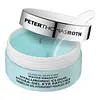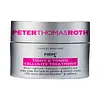What's inside
What's inside
 Key Ingredients
Key Ingredients

 Benefits
Benefits

 Concerns
Concerns

 Ingredients Side-by-side
Ingredients Side-by-side

Water
Skin ConditioningGlycerin
HumectantButylene Glycol
HumectantSodium Hyaluronate
HumectantHydrolyzed Collagen
EmollientCaffeine
Skin ConditioningCeramide NP
Skin ConditioningArnica Montana Flower Extract
MaskingAlthaea Officinalis Root Extract
Skin ConditioningAllantoin
Skin ConditioningTocopherol
AntioxidantHydrolyzed Sodium Hyaluronate
Skin ConditioningButyrospermum Parkii Butter
Skin ConditioningGlycyrrhiza Glabra Root Extract
BleachingScutellaria Baicalensis Root Extract
AstringentAngelica Gigas Root Extract
Skin ConditioningCimicifuga Racemosa Root Extract
AntimicrobialMorus Alba Bark Extract
Skin ConditioningPaeonia Lactiflora Root Extract
Skin ConditioningPhellinus Linteus Extract
Skin ConditioningPolygonum Multiflorum Root Extract
Skin ConditioningSesamum Indicum Seed Extract
Skin ConditioningSophora Angustifolia Root Extract
Skin ConditioningAloe Barbadensis Leaf Juice
Skin ConditioningRicinus Communis Seed Oil
MaskingAmorphophallus Konjac Root Powder
AbrasiveCarrageenan
Hydroxyacetophenone
AntioxidantHexylene Glycol
EmulsifyingPropanediol
SolventXylitylglucoside
HumectantSucrose
HumectantAnhydroxylitol
HumectantGlyceryl Caprylate
EmollientXylitol
HumectantBetaine
HumectantEthylhexylglycerin
Skin ConditioningGlucose
HumectantLecithin
EmollientMaltodextrin
AbsorbentMagnesium Aspartate
Skin ConditioningZinc Gluconate
Skin ConditioningAluminum Hydroxide
EmollientCopper Gluconate
Skin ConditioningPEG-60 Hydrogenated Castor Oil
EmulsifyingGellan Gum
Cyamopsis Tetragonoloba Gum
Emulsion StabilisingCeratonia Siliqua Gum
EmollientCalcium Chloride
AstringentTin Oxide
AbrasiveSynthetic Fluorphlogopite
Bis(Glycidoxyphenyl)Propane/Bisaminomethylnorbornane Copolymer
Caprylhydroxamic Acid
Disodium EDTA
1,2-Hexanediol
Skin ConditioningEthyl Hexanediol
SolventChlorphenesin
AntimicrobialPhenoxyethanol
PreservativeMica
Cosmetic ColorantCI 42090
Cosmetic ColorantCI 77891
Cosmetic ColorantCI 77491
Cosmetic ColorantWater, Glycerin, Butylene Glycol, Sodium Hyaluronate, Hydrolyzed Collagen, Caffeine, Ceramide NP, Arnica Montana Flower Extract, Althaea Officinalis Root Extract, Allantoin, Tocopherol, Hydrolyzed Sodium Hyaluronate, Butyrospermum Parkii Butter, Glycyrrhiza Glabra Root Extract, Scutellaria Baicalensis Root Extract, Angelica Gigas Root Extract, Cimicifuga Racemosa Root Extract, Morus Alba Bark Extract, Paeonia Lactiflora Root Extract, Phellinus Linteus Extract, Polygonum Multiflorum Root Extract, Sesamum Indicum Seed Extract, Sophora Angustifolia Root Extract, Aloe Barbadensis Leaf Juice, Ricinus Communis Seed Oil, Amorphophallus Konjac Root Powder, Carrageenan, Hydroxyacetophenone, Hexylene Glycol, Propanediol, Xylitylglucoside, Sucrose, Anhydroxylitol, Glyceryl Caprylate, Xylitol, Betaine, Ethylhexylglycerin, Glucose, Lecithin, Maltodextrin, Magnesium Aspartate, Zinc Gluconate, Aluminum Hydroxide, Copper Gluconate, PEG-60 Hydrogenated Castor Oil, Gellan Gum, Cyamopsis Tetragonoloba Gum, Ceratonia Siliqua Gum, Calcium Chloride, Tin Oxide, Synthetic Fluorphlogopite, Bis(Glycidoxyphenyl)Propane/Bisaminomethylnorbornane Copolymer, Caprylhydroxamic Acid, Disodium EDTA, 1,2-Hexanediol, Ethyl Hexanediol, Chlorphenesin, Phenoxyethanol, Mica, CI 42090, CI 77891, CI 77491
Water
Skin ConditioningCetearyl Alcohol
EmollientGlycerin
HumectantButylene Glycol
HumectantHydrogenated Farnesene
EmollientPolysorbate 20
EmulsifyingCoco-Caprylate/Caprate
EmollientUndecane
EmollientTriheptanoin
Skin ConditioningCitrus Aurantium Bergamia Fruit Extract
Skin ConditioningCaffeine
Skin ConditioningCitrullus Lanatus Seed Oil
EmollientTocopheryl Acetate
AntioxidantTocopherol
AntioxidantCastor Oil/Ipdi Copolymer
Dilinoleic Acid/Butanediol Copolymer
Maltodextrin
AbsorbentTridecane
PerfumingC9-12 Alkane
SolventCarbomer
Emulsion StabilisingSodium Hydroxide
BufferingSodium Benzoate
MaskingPotassium Sorbate
PreservativeCI 19140
Cosmetic ColorantParfum
MaskingPhenoxyethanol
PreservativeWater, Cetearyl Alcohol, Glycerin, Butylene Glycol, Hydrogenated Farnesene, Polysorbate 20, Coco-Caprylate/Caprate, Undecane, Triheptanoin, Citrus Aurantium Bergamia Fruit Extract, Caffeine, Citrullus Lanatus Seed Oil, Tocopheryl Acetate, Tocopherol, Castor Oil/Ipdi Copolymer, Dilinoleic Acid/Butanediol Copolymer, Maltodextrin, Tridecane, C9-12 Alkane, Carbomer, Sodium Hydroxide, Sodium Benzoate, Potassium Sorbate, CI 19140, Parfum, Phenoxyethanol
 Reviews
Reviews

Ingredients Explained
These ingredients are found in both products.
Ingredients higher up in an ingredient list are typically present in a larger amount.
Butylene Glycol (or BG) is used within cosmetic products for a few different reasons:
Overall, Butylene Glycol is a safe and well-rounded ingredient that works well with other ingredients.
Though this ingredient works well with most skin types, some people with sensitive skin may experience a reaction such as allergic rashes, closed comedones, or itchiness.
Learn more about Butylene GlycolCaffeine is most associated with coffee, tea, and cacao. In skincare, it helps with calming inflammation and is rich in antioxidants.
While caffeine is used to treat cellulite and and dark circles, further studies are needed to prove this. It has been believed to help with these skin conditions due to its ability to dilate blood vessels and increase blood flow.
Some studies are looking into caffeine's ability to protect against UV rays.
Learn more about CaffeineGlycerin is already naturally found in your skin. It helps moisturize and protect your skin.
A study from 2016 found glycerin to be more effective as a humectant than AHAs and hyaluronic acid.
As a humectant, it helps the skin stay hydrated by pulling moisture to your skin. The low molecular weight of glycerin allows it to pull moisture into the deeper layers of your skin.
Hydrated skin improves your skin barrier; Your skin barrier helps protect against irritants and bacteria.
Glycerin has also been found to have antimicrobial and antiviral properties. Due to these properties, glycerin is often used in wound and burn treatments.
In cosmetics, glycerin is usually derived from plants such as soybean or palm. However, it can also be sourced from animals, such as tallow or animal fat.
This ingredient is organic, colorless, odorless, and non-toxic.
Glycerin is the name for this ingredient in American English. British English uses Glycerol/Glycerine.
Learn more about GlycerinMaltodextrin is a polysaccharide. It is derived from starch such as rice, corn, wheat, or potato starch.
In food, Maltodextrin is used to improve the texture and thicken a product. Due to its structure, it can help create a gel texture. As an emulsion stabilizer, it helps keep the ingredients in a product together.
As a polysaccharide, Maltodextrin has moisturizing properties. Polysaccharides are a type of carbohydrate. The top layer of skin uses polysaccharides to retain water, keeping the skin hydrated.
Maltodextrin is water soluble and has a sweet taste.
Learn more about MaltodextrinPhenoxyethanol is a preservative that has germicide, antimicrobial, and aromatic properties. Studies show that phenoxyethanol can prevent microbial growth. By itself, it has a scent that is similar to that of a rose.
It's often used in formulations along with Caprylyl Glycol to preserve the shelf life of products.
Tocopherol (also known as Vitamin E) is a common antioxidant used to help protect the skin from free-radicals and strengthen the skin barrier. It's also fat soluble - this means our skin is great at absorbing it.
Vitamin E also helps keep your natural skin lipids healthy. Your lipid skin barrier naturally consists of lipids, ceramides, and fatty acids. Vitamin E offers extra protection for your skin’s lipid barrier, keeping your skin healthy and nourished.
Another benefit is a bit of UV protection. Vitamin E helps reduce the damage caused by UVB rays. (It should not replace your sunscreen). Combining it with Vitamin C can decrease sunburned cells and hyperpigmentation after UV exposure.
You might have noticed Vitamin E + C often paired together. This is because it is great at stabilizing Vitamin C. Using the two together helps increase the effectiveness of both ingredients.
There are often claims that Vitamin E can reduce/prevent scarring, but these claims haven't been confirmed by scientific research.
Learn more about TocopherolWater. It's the most common cosmetic ingredient of all. You'll usually see it at the top of ingredient lists, meaning that it makes up the largest part of the product.
So why is it so popular? Water most often acts as a solvent - this means that it helps dissolve other ingredients into the formulation.
You'll also recognize water as that liquid we all need to stay alive. If you see this, drink a glass of water. Stay hydrated!
Learn more about Water